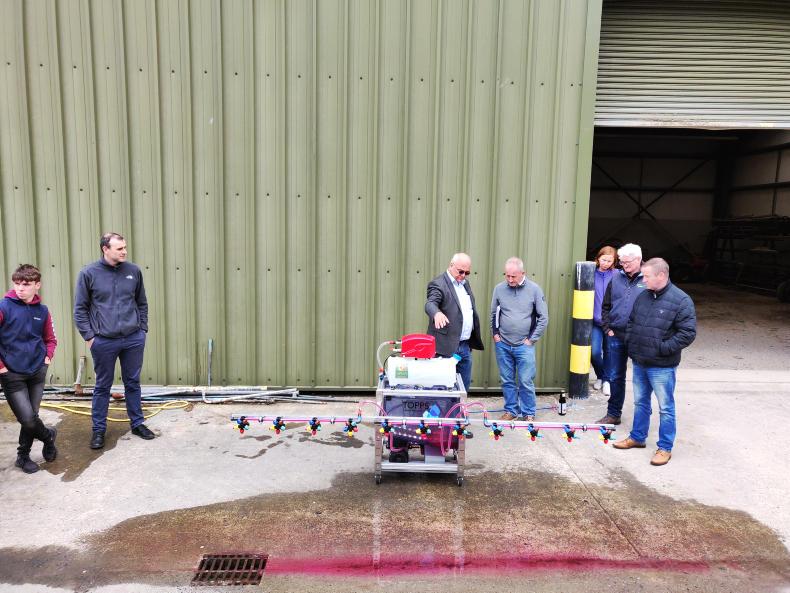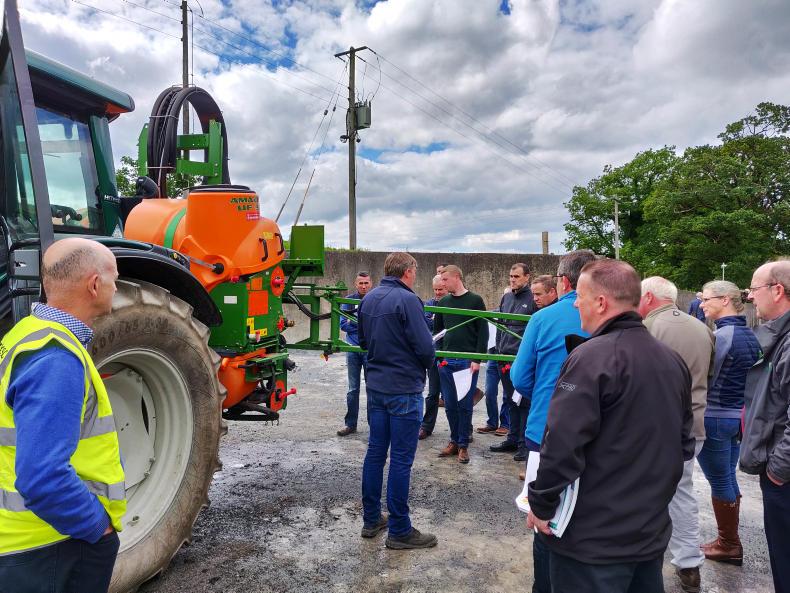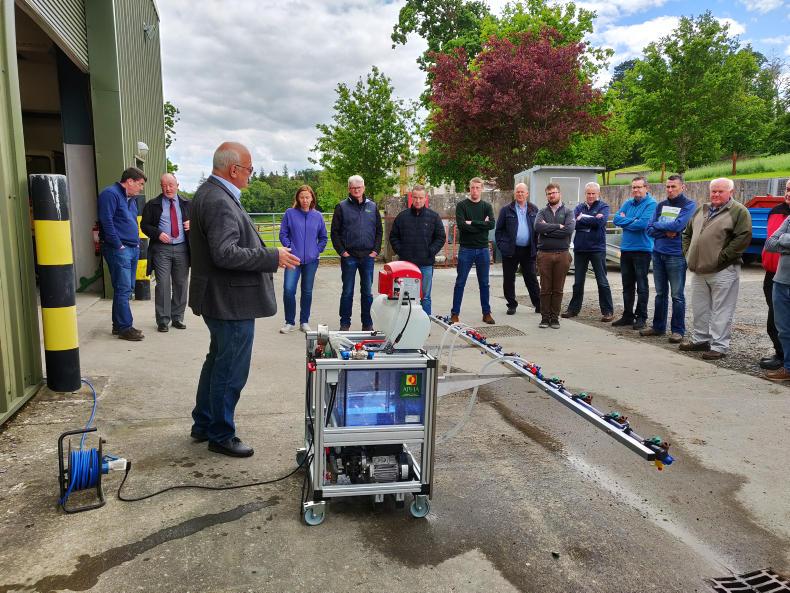The most common herbicide in Ireland is MCPA, a powerful chemical compound which is used for rush control in grassland. In the case of poor farm practice, these solutions can make their way into waterways, which has potential health and environmental implications. Drinking-water regulations state a permissible trace of 0.10mg/l is allowable, a level which ensures no impact on human health. To address this environmental safety measure, the EU-backed Train Operators to Promote best management Practices & Sustainability (TOPPS) programme hosted training events at Ballyhaise, Kildalton, and Pallaskenry Agricultural Colleges this week.
Best management practices
Point source pollution from farmyards constitutes 50% of the entry routes of Plant Protection Products (PPP) to water. At the training events, TOPPS detailed the best management practices to reduce the risk of PPP water contamination.
Transportation of PPP
When being transported, PPP must be in their original containers with intact, readable labels. Safe and secure loads are advised, with no unnecessarily large amounts of product being moved at a given time. Preparation for the instance of a spillage is crucial, with an emergency plan set in place.

Storage of PPP
Storage of PPP must be away from all sensitive zones, such as water protection areas, in lockable rooms or containers. The store should never be left unattended or open to unauthorised persons.
Before spraying
Before spraying, you should assess whether field conditions will allow safe and effective application with inspected and functionable sprayers. It is important not to fill sprayers with water directly from drinking water sources as this has potential to cause contamination. Only use approved PPP, complying with all their conditions of use.
During spraying
During spraying, use practical solutions to avoid overlaps and reduce drift. Ensure not to spray buffer zones or any environmentally sensitive areas. Only spray while driving at the correctly calibrated speed.
After spraying
Enforce a strict and thorough protocol for cleaning equipment after spraying. This is one of the most important activities where farmers can minimise their risk of point source pollution. Correct rinsing and cleaning afterward are vital to successful spraying and protection of the environment.

Best management practice in the use of herbicides and pesticides training event took place at Ballyhaise Agricultural College.
Waste and remnant management
Care should be given to the safe storage of sprayers and correct disposal of PPP containers. Farmers should ensure to triple-rinse all containers in accordance with the good practice guide for empty pesticide containers.
Diffuse sources were also highlighted at the event, with Dr Manfred Rottele, TOPPS programme leader, addressing contamination as a result of drift, constituting 5% of all PPP contamination. Dr Rottele demonstrated the effectiveness of newly designed hydraulic nozzles, which have been tested to reduce drift by 70%.
A further 35% of PPP contamination comes as a result of run-off. James Caplis from the Department of Agriculture, Food and the Marine detailed the Stripe protocol, a surface water tool for reducing the impact of pesticides on the environment.
Also speaking at the event was John Keogh, CEO of the Animal and Plant Health Association. He told attendees of the event that “a single drop of herbicide can breach the drinking water limit in a small stream for over 33km”.
The event comprised of a morning of classroom-based learning, followed by a practical demonstration in the afternoon – using fully functioning demonstration sprayers. The information provided was specially tailored to Irish farming enterprises and practices, with the training intended for farming organisations.
The most common herbicide in Ireland is MCPA, a powerful chemical compound which is used for rush control in grassland. In the case of poor farm practice, these solutions can make their way into waterways, which has potential health and environmental implications. Drinking-water regulations state a permissible trace of 0.10mg/l is allowable, a level which ensures no impact on human health. To address this environmental safety measure, the EU-backed Train Operators to Promote best management Practices & Sustainability (TOPPS) programme hosted training events at Ballyhaise, Kildalton, and Pallaskenry Agricultural Colleges this week.
Best management practices
Point source pollution from farmyards constitutes 50% of the entry routes of Plant Protection Products (PPP) to water. At the training events, TOPPS detailed the best management practices to reduce the risk of PPP water contamination.
Transportation of PPP
When being transported, PPP must be in their original containers with intact, readable labels. Safe and secure loads are advised, with no unnecessarily large amounts of product being moved at a given time. Preparation for the instance of a spillage is crucial, with an emergency plan set in place.

Storage of PPP
Storage of PPP must be away from all sensitive zones, such as water protection areas, in lockable rooms or containers. The store should never be left unattended or open to unauthorised persons.
Before spraying
Before spraying, you should assess whether field conditions will allow safe and effective application with inspected and functionable sprayers. It is important not to fill sprayers with water directly from drinking water sources as this has potential to cause contamination. Only use approved PPP, complying with all their conditions of use.
During spraying
During spraying, use practical solutions to avoid overlaps and reduce drift. Ensure not to spray buffer zones or any environmentally sensitive areas. Only spray while driving at the correctly calibrated speed.
After spraying
Enforce a strict and thorough protocol for cleaning equipment after spraying. This is one of the most important activities where farmers can minimise their risk of point source pollution. Correct rinsing and cleaning afterward are vital to successful spraying and protection of the environment.

Best management practice in the use of herbicides and pesticides training event took place at Ballyhaise Agricultural College.
Waste and remnant management
Care should be given to the safe storage of sprayers and correct disposal of PPP containers. Farmers should ensure to triple-rinse all containers in accordance with the good practice guide for empty pesticide containers.
Diffuse sources were also highlighted at the event, with Dr Manfred Rottele, TOPPS programme leader, addressing contamination as a result of drift, constituting 5% of all PPP contamination. Dr Rottele demonstrated the effectiveness of newly designed hydraulic nozzles, which have been tested to reduce drift by 70%.
A further 35% of PPP contamination comes as a result of run-off. James Caplis from the Department of Agriculture, Food and the Marine detailed the Stripe protocol, a surface water tool for reducing the impact of pesticides on the environment.
Also speaking at the event was John Keogh, CEO of the Animal and Plant Health Association. He told attendees of the event that “a single drop of herbicide can breach the drinking water limit in a small stream for over 33km”.
The event comprised of a morning of classroom-based learning, followed by a practical demonstration in the afternoon – using fully functioning demonstration sprayers. The information provided was specially tailored to Irish farming enterprises and practices, with the training intended for farming organisations.








 This is a subscriber-only article
This is a subscriber-only article










SHARING OPTIONS: